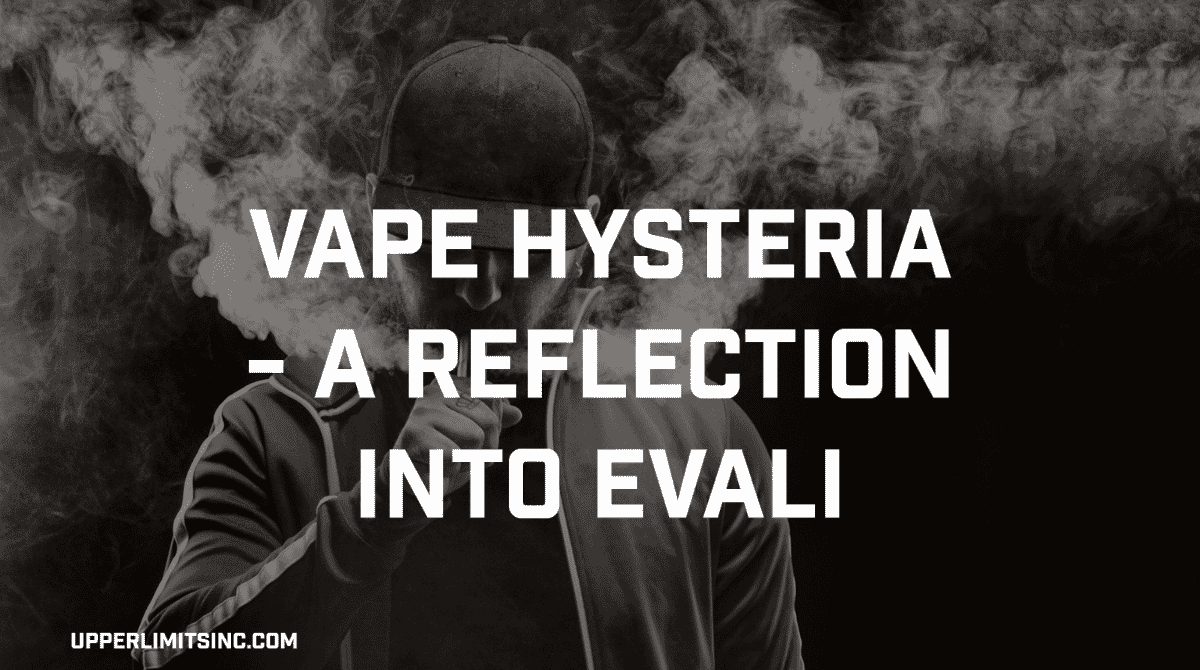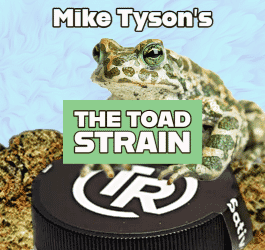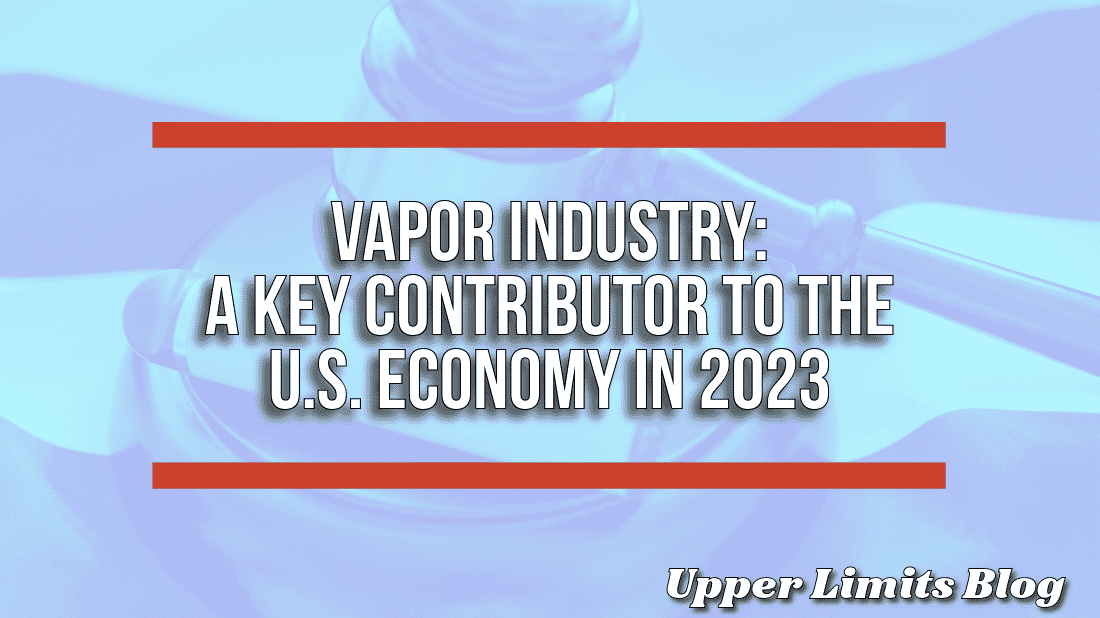Vape Hysteria - A Reflection Into EVALI

Harm Reduction and Hysteria - A Reflection Into EVALI
2019 will be remembered as a tumultuous year for the vaping industry as April brought with it the first documented case of an obscure yet
lethal respiratory illness being vaguely linked to the use of vaporizers. As unfortunate patients in both Illinois and Wisconsin fell ill and
subsequently died, the CDC seized the moment and quickly deemed “vaping” as the culprit due to the only external commonality between the
patients being the use of vaporizers. Dubbing the mysterious illness as EVALI (E-cigarette or Vaping Associated Lung Injury) the CDC warned
of the dangers of using electronic vaporizers of all forms and functions. While the number of those falling ill increased, and the area of effect
widened, little to no information was shared by officials regarding the type of vaporizers being used nor what substances were being
vaporized within those devices, culminating in the perfect storm of fear-driven hysteria. This fear has understandably caused many to
abandon electronic nicotine delivery systems (hereafter referred to as ENDS) in favor of traditional analog cigarettes, undoing much of the
progress made by those using ENDS to quit their habit of cigarette smoking.
How could something that’s marketed as a healthier alternative to cigarette smoking be causing the acute respiratory failure? It’s a story all
too familiar with America. Large multinational tobacco corporations put profit over people, intentionally misleading their consumers and
outright lying about the effects of their products. Is this an instance of the history of corporate greed repeating itself, or of misguidance and
misinformation quickly spreading through social and legacy media due to an intentionally vague CDC and FDA?
Since 2007 electronic nicotine delivery systems have been marketed and generally viewed by the public as a healthier alternative to
traditional combustible cigarettes. ENDS or nicotine vaporizers, as they are also referred to, work by heating water-soluble glycerin containing
nicotine and USP food-grade flavoring (e-liquid) to a temperature just above its boiling point. This creates an aerosolized cloud of flavored
nicotine while avoiding the extreme temperatures and rampant chemical changes caused by the combustion of paper and tobacco. In doing so
many of the largest chemical contributors to smoking-related illness are greatly reduced if not eliminated. A study conducted in 2015 by the
U.K.’s Royal College of Physicians, the same body of medical doctors who published a landmark report on the dangers of smoking tobacco in
1962, reported that “e-cigarette use is unlikely to exceed %5 of the harm from smoking tobacco.”
At face value, such a study seems to suggest that using electronic nicotine delivery systems containing properly manufactured e-liquid is
likely %95 safer than traditional combustible cigarettes. If this is the case, how are so many falling ill from nicotine vaping through the use of
ENDS after such a short time of exposure? How are vapers turning into hospital patients presenting with Lipoid Pneumonia-like symptoms (an
illness caused by the inhalation of non-water soluble, fat resembling oils)?. This is especially odd considering that no lipoid oils are listed as
ingredients by any FDA-compliant nicotine E-Liquid manufacturers. The simple answer; these patients are not falling ill from nicotine vaping,
but from vaping a substance entirely different.
After months of autopsies and the testing of products being used by those who fell ill, the CDC has finally announced that they have found
a common “chemical of concern” in all 29 biological samples they have tested. The chemical of concern is Vitamin E acetate, a pale yellow
viscous liquid that is a synthetic petroleum-based form of the naturally occurring vitamin E. Further information on the CDC’s announcement
can be found just below.
“ Analyses of bronchoalveolar lavage (BAL) fluid samples (fluid samples collected from the lungs) of patients with an e-cigarette, or vaping,
product use-associated lung injury (EVALI) identified vitamin E acetate, an additive in some THC-containing e-cigarette, or vaping, products.
CDC laboratory test results of BAL fluid samples from 29 patients submitted to CDC from 10 states found vitamin E acetate in all of the samples.
THC was identified in 82% of the samples and nicotine was identified in 62% of the samples.
CDC tested for a range of other chemicals that might be found in an e-cigarette, or vaping, products, including plant oils, petroleum distillates
like mineral oil, MCT oil, and terpenes (which are compounds found in or added to THC products). None of these chemicals of concern were
detected in the BAL fluid samples tested.
This is the first time that we have detected a chemical of concern in biological samples from patients with these lung injuries. These findings
provide direct evidence of vitamin E acetate at the primary site of injury within the lungs."
Widely used as a thickening agent in black market THC-containing cartridges to mask the thin and runny viscosity of impotent or altogether
fake THC distillate, vitamin E acetate is water insoluble, meaning it doesn’t dissolve and dissipate when mixed with water. This quickly creates
an issue for the lungs as the chemical compound collects and cannot be evacuated by the body through the expectoration (coughing up) of
the water vapor naturally found in the lungs. Once the lungs are internally coated in vitamin E acetate the free exchange of oxygen and
carbon dioxide can no longer take place. This forces physicians to intubate with breathing machines and/or have medical devices remove,
oxygenate, then replace their patient's blood in hopes of maintaining healthy blood oxygen levels until the chemical is removed enough for
the patient to begin breathing autonomously. I reiterate, that no FDA-compliant nicotine e-liquid manufacturers list vitamin E acetate as an
ingredient in their product.
While the avoidable deaths of fellow humans are always saddening and disappointing, so is the wanton disregard for public health displayed
by the CDC through how the situation was handled. Early on it was suggested by vaping advocates and various health officials that something
other than nicotine e-liquid could be to blame for the outbreak due to the fact that throughout 12 years of widespread ENDS use, no lipoid
pneumonia-like illnesses had been recorded due to nicotine vaping alone. Yet still, the CDC chose to be intentionally vague while hiding
behind the guise of public safety. How many people who incorrectly took the CDC’s warning as a warning specifically regarding ENDS
continued to buy and use these tainted THC cartridges? How many ex-smokers unwillingly went back to traditional combustible cigarettes due
to being misled? Every day the number of people falling ill, or returning to cigarettes continues to rise, in no small part to the mishandling of
the situation.
Article by Jordan Crawford
Read Next: What is Delta 8?











Comments